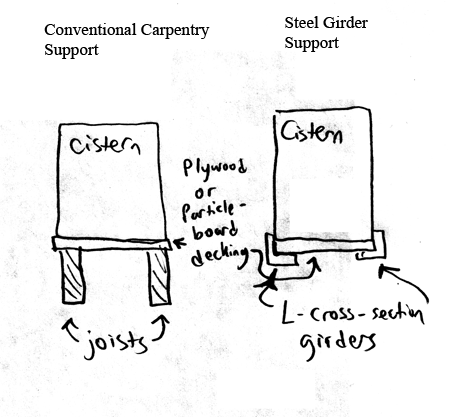|
|
|
cistern support
Tuesday, October 27 2009
In yesterday's entry, I wrote about the problem of rectangular solid shapes holding their flat-sided forms when filled with water. The rectangular solid in question was a HDPE box designed to hold 32 gallons of something other than water. So today I put some effort into strengthening the walls of that box so that they wouldn't bulge ominously when filled with the substance I'd bought it to store. I cut six rectangular pieces of particleboard to put in the rectangular insets in its otherwise-featureless-sides and then welded a band of Cor-Ten steel to serve as something of a girdle to hold all those boards in place, thereby reducing the bulging.
In the brownhouse, where this reinforced box will serve as a 32 gallon cistern, I will have to install a solid shelf for it to sit on. A completely-full 32 gallon cistern contains 256 pounds of water (over an eighth of a ton). In conventional carpentry, such weight implies substantial structure to support it. But I wanted to maximize the space beneath the cistern for other uses and avoid running, say, two by four or two by six joists under the shelf. Instead I chose to use small steel girders with L-shaped cross sections. Such girders are incredibly resistant to flexing, although they do like to twist if the forces resolve to do that. The great benefit of such girders is that they can support their loads without placing much material beneath them. For the cistern support, all I'd need would be some particleboard decking and the horizontally-oriented legs of the girders to support the weight. Refer to this hasty illustration:

For linking purposes this article's URL is:
http://asecular.com/blog.php?091027 feedback
previous | next |
